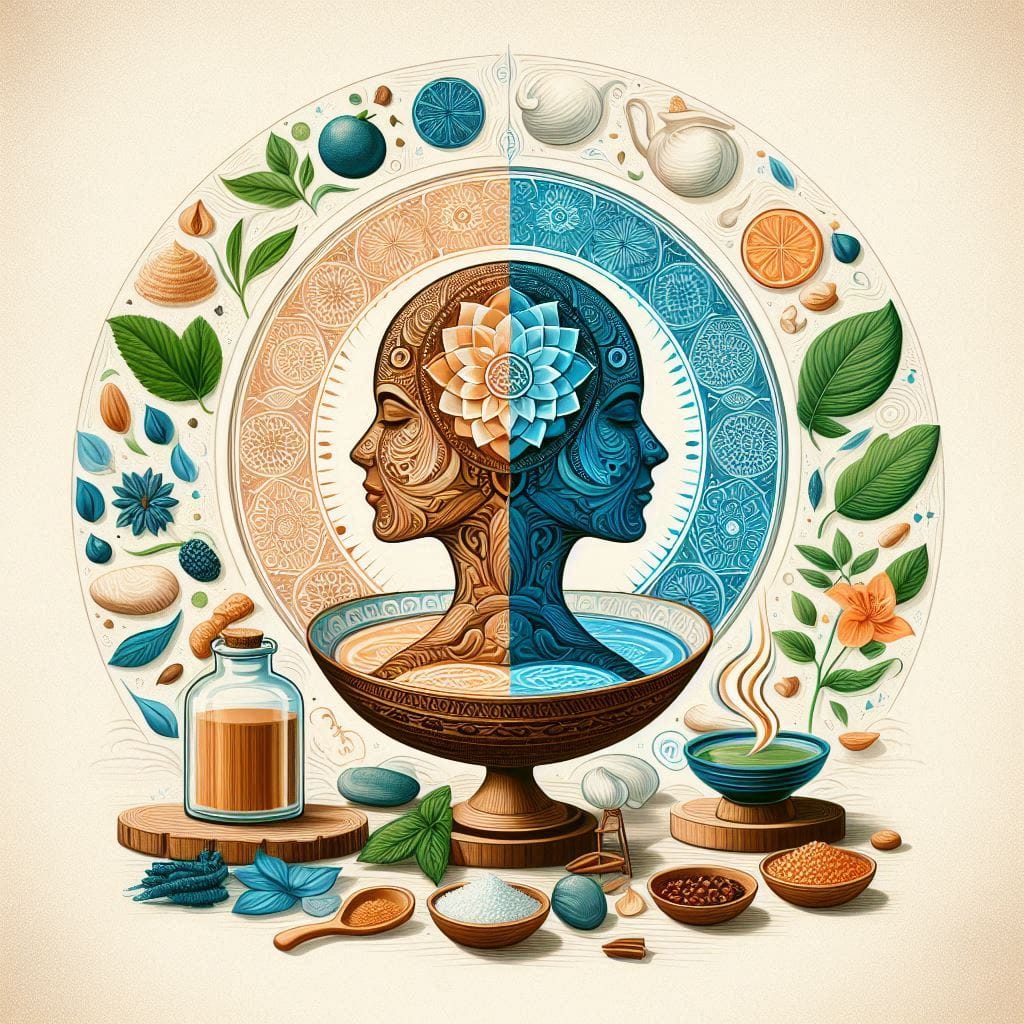
Ayurveda, an ancient holistic healing system from India, emphasizes the balance between mind, body, and spirit for optimal health and well-being. This system has been in practice for over 5,000 years and has been gaining popularity in the West due to its effectiveness in managing various health conditions. In this article, we will explore the connection between Ayurveda and mind-body health and how it can benefit individuals seeking
Ayurveda, the ancient healing system of India, is more than just a method of treating illness—it is a complete science of life. Derived from the Sanskrit words Ayur (life) and Veda (knowledge), Ayurveda offers profound insights into achieving a balanced, healthy, and meaningful life. At its core, Ayurveda emphasizes maintaining harmony between the mind, body, and spirit—the three pillars of human existence.
This holistic approach sees health not as the absence of disease but as a state of vibrant energy, where a person feels physically strong, mentally clear, emotionally stable, and spiritually connected.
The Tridosha Theory: Foundation of Balance between mind-body-health
Ayurveda teaches that all humans are made of five elements: earth, water, fire, air, and ether. These elements combine to form three vital energies or doshas:
- Vata (Air + Ether) – governs movement, breathing, circulation, and nervous system activity.
- Pitta (Fire + Water) – governs digestion, metabolism, and transformation.
- Kapha (Earth + Water) – governs stability, structure, lubrication, and immunity.
Each person is born with a unique balance of these doshas, known as their Prakriti. When the doshas remain in balance, a person enjoys good health. But when they become imbalanced (Vikriti) due to poor diet, stress, lifestyle, or environmental changes, it leads to disease and mental disturbances.
Thus, Ayurveda’s main goal is to maintain or restore balance among the doshas—bringing harmony to the body, calming the mind, and uplifting the spirit.
you may also like https://thrievly.com/herbs-in-ayurveda-natures-healing-pharmacy-for-mind-body-spirit/
Balancing the Body mind-health-connection
Ayurveda treats the body as a sacred temple. Physical balance is achieved through:
1. Personalized Diet (Ahara)
Food is considered medicine in Ayurveda. Each dosha has dietary guidelines to support digestion and maintain equilibrium:
- Vata types need warm, moist, grounding foods like soups and cooked grains.
- Pitta types benefit from cooling, hydrating foods like cucumbers, melons, and leafy greens.
- Kapha types thrive on light, spicy, and warming foods that stimulate metabolism.
Eating in alignment with your constitution and the seasons strengthens digestion (agni) and prevents the buildup of toxins (ama).
2. Daily Routines (Dinacharya)
Daily rituals help align the body’s rhythms with nature. Practices include:
- Waking up before sunrise
- Tongue scraping and oil pulling
- Warm water with herbs
- Gentle exercise or yoga
- Abhyanga (self-massage with oil)
- Regular meals and sleep times
These routines cleanse the body, regulate the doshas, and instill a sense of physical well-being.
3. Herbs and Remedies
Ayurveda uses a vast range of herbs to nourish tissues, detoxify the system, and correct imbalances. Examples include:
- Ashwagandha for strength and stress reduction
- Triphala for digestion and elimination
- Turmeric for inflammation and immunity
These herbs are chosen based on individual needs, ensuring targeted healing.
Calming the Mind body health
Ayurveda recognizes the mind (manas) as a powerful force in health. Emotional disturbances like stress, fear, anger, and grief can disrupt the doshas and affect physical health. To calm and balance the mind, Ayurveda uses:
1. Meditation and Mindfulness
Daily meditation helps quiet mental chatter, regulate emotions, and promote mental clarity. It connects the individual with the present moment and cultivates sattva—a state of peace and harmony.
2. Pranayama (Breath Control)
Breathing exercises regulate energy flow and pacify the nervous system. Specific techniques are prescribed for each dosha:
- Vata: deep, grounding breaths
- Pitta: cooling, calming breaths
- Kapha: stimulating, energizing breaths
3. Mental Diet
Just like food, what we “consume” mentally affects our state of mind. Ayurveda recommends surrounding oneself with positive thoughts, uplifting environments, and compassionate relationships to maintain emotional balance.
you may also like https://thrievly.com/ayurvedic-diet-eating-according-to-your-dosha/
Nourishing the Spirit
In Ayurveda, the spirit (Atman) is considered the true self—pure, eternal, and divine. Health is not complete without a connection to one’s inner self and a sense of purpose.
1. Sattvic Living
Sattva represents purity, clarity, and balance. A sattvic lifestyle involves:
- Eating clean, fresh, vegetarian food
- Living in harmony with nature
- Practicing non-violence (ahimsa) and truthfulness
- Serving others with compassion
This elevates the consciousness and strengthens the connection with the spirit.
2. Spiritual Practices
Regular spiritual practices, such as prayer, chanting, yoga, or sacred rituals (puja), help cleanse the heart and mind. These practices align the individual with universal energies and foster inner peace.
3. Dharma and Purpose
Ayurveda teaches that everyone has a unique role (Dharma) in life. When individuals live according to their higher purpose, it brings fulfillment, reduces stress, and maintains spiritual balance.
Healing as a Journey, Not an Event
Unlike modern medicine, which often targets symptoms, Ayurveda sees healing as a personal journey toward wholeness. It encourages deep self-awareness, conscious choices, and connection with nature’s rhythms.
Balance doesn’t mean perfection. It means living in alignment with your true nature, making space for rest, self-care, and spiritual growth.
The Benefits of a Balanced Mind-Body Connection
- When the mind and body are in balance, we experience a wide range of benefits, including improved physical health, mental clarity, emotional stability, and spiritual growth.
- By promoting a balanced mind-body connection through Ayurvedic practices and lifestyle factors, we can experience greater vitality, happiness, and fulfillment in our lives.
- Ayurveda recognizes that each person is unique and offers personalized treatment plans to support individual health and well-being.
Conclusion: A Holistic Path to Harmony
Ayurveda is a time-tested path that teaches how to live in balance with ourselves, others, and the universe. By nurturing the body with proper food and routine, calming the mind through mindfulness, and connecting the spirit through purpose and devotion, Ayurveda offers a complete system of healing.
In a world that often separates the physical from the spiritual, Ayurveda reminds us that everything is connected—and true wellness is achieved when body, mind, and spirit exist in perfect harmony.
FAQs
How does Ayurveda promote mind-body health?
Ayurveda promotes mind-body health by emphasizing the connection between the mind and body and offering practices like meditation, yoga, and a balanced diet that can help promote overall well-being.
Can Ayurveda help with mental health conditions like anxiety and depression?
Yes, Ayurvedic practices like meditation, yoga, and the use of herbs and supplements have been shown to have a positive impact on mental health conditions like anxiety and depression.
Is Ayurveda a safe practice?
Ayurveda is generally considered safe, but it’s important to consult with a qualified practitioner before starting any new Ayurvedic practices or using herbs and supplements.
Can Ayurveda be used in conjunction with Western medicine?
Yes, Ayurveda can be used in conjunction with Western medicine. However, it’s important to consult with your healthcare provider before incorporating Ayurvedic practices into your treatment plan.



